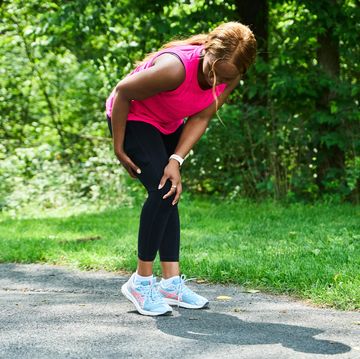It’s easy to understand why so many people believe that running is bad news for the knees over time. Yes, your knees face substantial impact with each stride. Sure, runners are occasionally sidelined by knee injuries. And everyone knows someone who quit running because of knee pain.
But most medical research continues to exonerate running as a cause of knee osteoarthritis.
The most recent of these reports, published online last week by Arthritis Care & Research, provides interesting and compelling information. That’s because the research team didn’t set out to study runners. The 2,637 participants came from a large sample called the Osteoarthritis Initiative, funded by the National Institutes of Health and a handful of Big Pharma companies.
Eight years after joining the study, subjects (56 percent female, average age: 64) were given a physical-activity questionnaire. This revealed that 778 of them (29.5 percent) had participated in some amount of running at some point in their life.
The researchers, from four hospitals across the U.S., had hypothesized that “a history of leisure running may increase the risk for knee symptoms and ROA, even at lower levels.” (ROA refers to radiographic evidence of arthritis.) All subjects in the Osteoarthritis Initiative underwent radiograpy (X-rays) of their knees, adding to the strong evidence underlying the study.
The results were opposite to what the investigators had expected. This forced them to conclude: “A history of leisure running is not associated with increased odds of prevalent knee pain, ROA, or SOA [symptoms of arthritis]. In fact, for knee pain, there was a dose-dependent inverse association with runners.”
This means that the people who ran the most had the least knee pain. "This was true across all age groups and for running at any time in one's life," noted first author Grace Hsaio-Wei Lo, M.D, an assistant professor at the Baylor College of Medicine, in an email to Runner's World. (For more data, see the table below.)
What’s more, the subjects who were still running had less knee pain (reported by 21.1 percent of them) than those who had quit running (25.3 percent), who had less pain than those who had never run (29.6 percent). Because the study was cross-sectional in design, it can’t prove cause-and-effect. Lo believes the runners might have reported less pain because that had lower BMIs than the non-runners, better muscle strength or balance, or an overall healthier lifestyle.
Only two to five percent of the runners defined themselves as “competitive.” The researchers contend this is one of the principal strengths of their work.
"This cohort was not created based on elite running status, making these findings potentially more applicable to a broader population than many prior studies," they wrote. Runners were grouped into Low, Middle, and High groups if they had done at least 250, 800, or 2,000 running workouts in their lifetime.
First author Lo adds: “This is the largest study to look at running similar to what the everyday person would do. Also, because it was part of the very large Osteoarthritis Initiative, we used high-quality X-rays and methods of assessing knee symptoms.”
Percentage Of Runners Reporting Frequent Knee Pain
| Non runners | 41.1 percent |
| Low runners | 34.9 percent |
| Middle runners | 39.2 percent |
| High runners | 31.3 percent |













